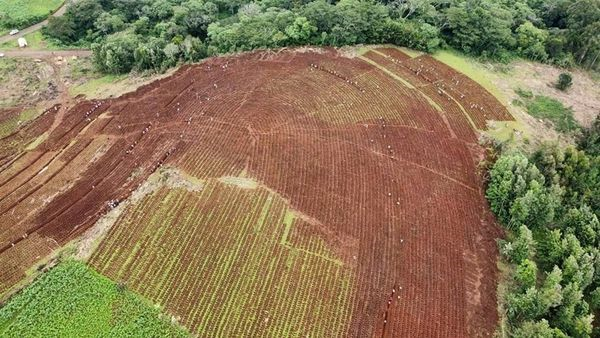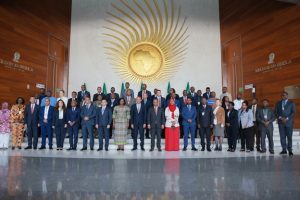
Ethiopia is striving to increase its forest coverage by strengthening its forest conservation efforts and through mass plantation. With this continuous effort, both planting billions of new seedlings and conserving the available forest, Ethiopia’s forest coverage has increased to 23.6% in 2024 from 17.2% in 2019. This shows a significant move to attain the country’s target of increasing the country’s forest coverage to 30% by 2030.
In addition to investing in plantation and conservation, experts in the field recommend applying technological systems in the sector to improve the information gathering, data administration and control the situation of the forest resource. In this regard, especially since the launching of the Green Legacy initiative in 2019 by Prime Minister Abiy Ahmed (PhD), in addition to planting billions of trees within a single season, Ethiopia has introduced managing the plantation and the follow-up of the planted trees using technological advancements. Still, the sector demands strengthening the implementation of technologies.
According to various documents, Ethiopia was covered by dense forest a century ago. Despite Ethiopia’s being covered by forests, its forest coverage was slashed down during the past several decades. Research disclosed that over 100,000 hectares of natural forest were destroyed and burned by fire annually during the past several decades. As a result of fast and huge deforestation across the country, Ethiopia was exposed to drought, land degradation, desertification, food insecurity, and poverty as it lost its forest resources. The Green Legacy initiative is playing a crucial role in reversing desertification, land degradation, and drought as the initiative helped the country to plant over 30 billion trees within five years. This effort of recovering the deforested areas to build a green economy is bringing meaningful results. To achieve the goal, this extensive investment should be supported and strengthened through technology.
To properly reverse the deforestation and desertification challenges and to increase forest coverage, in addition to planting seedlings annually, there is a call for administering the forest resources using technological advancements in the sector. Modernizing the forest management system is a critical action to preserve the available forest, to follow the growth of the new seedlings, and to know the economic potential of the forest resource. The forest resources should be documented properly by applying technology-supported systems.
During the launching ceremony of the 2024 plantation season, it was reported that Ethiopia’s forest coverage has increased to 23.6% at this time from 17.2% in 2019. The research about the forest coverage of Ethiopia was conducted jointly with internationally experienced institutions based on the United Nations Climate Change Convention. The survey also indicated that it used the most advanced technology during the survey on forest coverage showing Ethiopia’s efforts in applying technology in the sector.
Worku Zewdie (PhD) is a Forest Sector Researcher and Instructor. He is also a Forest and Satellite Information Advisor. For Worku, currently, technology is becoming necessary for every sector as it makes every task easy and helps to perform tasks scientifically. As to him, the forest sector also needs information supported by technology.
According to the researcher, there are three types of information systems in forest resources. Information gathered from the earth, information gathered using airplanes or web, and data gathered from satellites. The three types of information are gathered using three methods, i.e. optic (using the solar system), web system and the third one is using light reflection.
According to the researcher, the data gathering methods help to know the forest resource properly as it helps to know the specific location of the forest resource and the density and coverage of the available forest. Using this method also helps to know the height of the trees, the branches, and the composition of the forest. “This technology can help us to know the tree’s height, branches, the composition, and the overall density of the forest coverage” the researcher stated adding applying the modern methods helps to understand the available forest.
Since 2019, Ethiopia has been planting billions of seedlings annually and the government announced that it applied technological methods to follow the plantation and the growth of the trees. In this regard, the researcher stated that by applying technological methods, it is possible to know the specific places where the seedlings are planted and to follow the growth and the current situation of the planted seedlings. As to him, if the technology is applied properly, it is possible to know the current situation and growth rate of the seedlings planted since 2019.
Not only is that, as to Worku, using technologies, it is also possible to measure the carbon, nitrogen, and the number of substances in the leaves of the trees. By measuring these substances in the leaves of the seedlings, it helps to analyze the growth stage of the seedlings.
Worku stated that there are promising activities in introducing technology to administer the forest resources in Ethiopia. Especially higher education institutions and research centers in Ethiopia are playing a crucial role in this regard, mentioned the previous year’s limitations in applying technological products in the forest sector. He commends the significant improvements being registered in the sector, despite the limitations which still need further interventions. Especially, there are limitations in regional states in using technology, as to him.
According to him, despite the developments in using technology to administer forest resources in recent years, still it is on its initial phase which needs further development to fully apply advanced technologies. Despite he appreciated the current technologies being implemented in the forest resources in Ethiopia, compared with the advancement of technologies being used by the rest of the world, he stated that a lot remains to do.
According to Worku, forest coverage is identified at the international level to about climate change and carbon emission. “To know Ethiopia’s forest coverage and the areas where the forest is presented, the international organizations sent their experts to know and identify Ethiopia’s forest to know the forest coverage using the technologies mentioned above. During this time, by studying the forest using the latest technologies and documenting the data properly, as a country we have to prove that the local efforts can meet the international standard. Data should be documented using technological advancements.”
Unless the data documentation system is strengthened using technologies to work together with international systems, we may remain behind. “By strengthening the initial efforts in applying technological advancements in the forest sector, we have to improve it,” he stated. As we are in the era of technology, there is access to free data and by developing the capacity of professionals and data analyzing materials like computer, software and other products, it is important to create a suitable ecosystem for the sector.
For his part, Ethiopian Forest Development Deputy Director, Motuma Tolera (PhD) said that efforts are underway to administer the forest resource of the country using technology. He added that technology has been given due attention in the forest sector internationally adding that this year’s theme for International Day of Forest “Forests and Innovation: New Solutions for Better World” indicates the attention given to using technological innovations in the forestry sector.
Motuma stated that at Ethiopian level, there are efforts to identify the technologies implemented so far, the changes that the applied technologies bring in the forest resources, and the current level of the country in using forest technologies.
According to the Deputy Director, different technological products are joining the sector that can help to control deforestation and restore degraded forest areas. New technological innovations are coming to the sector that can help to know and control the changes within hours. In addition, some technologies can analyze and alert wildfires or predict wildfires. Motuma further stated that Ethiopia is working to make the country’s forest resource conservation and management system scientifically using technologies.
BY DARGIE KAHSAY
THE ETHIOPIAN HERALD FRIDAY 16 AUGUST 2024





